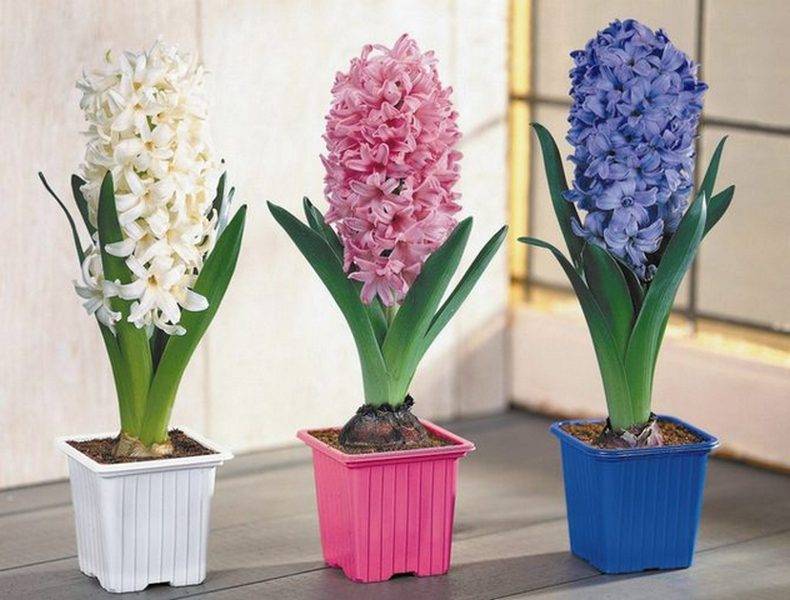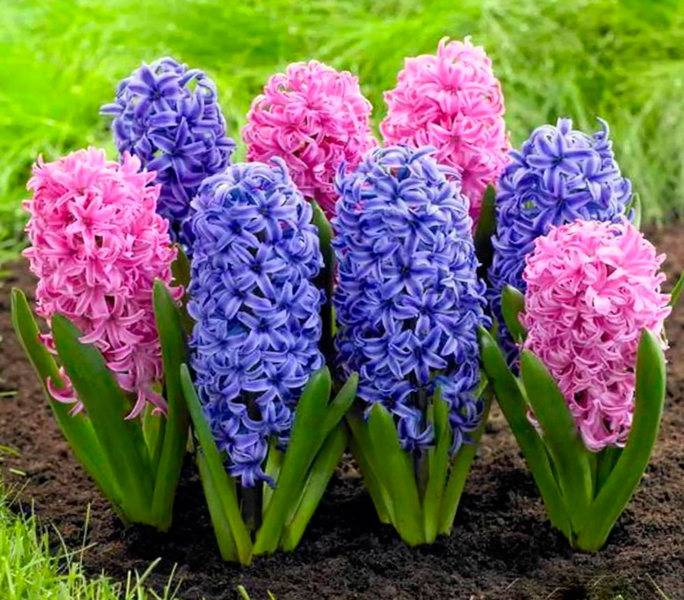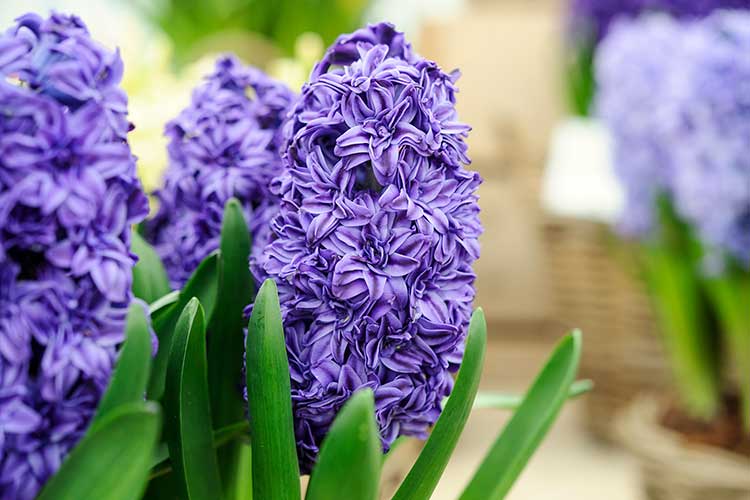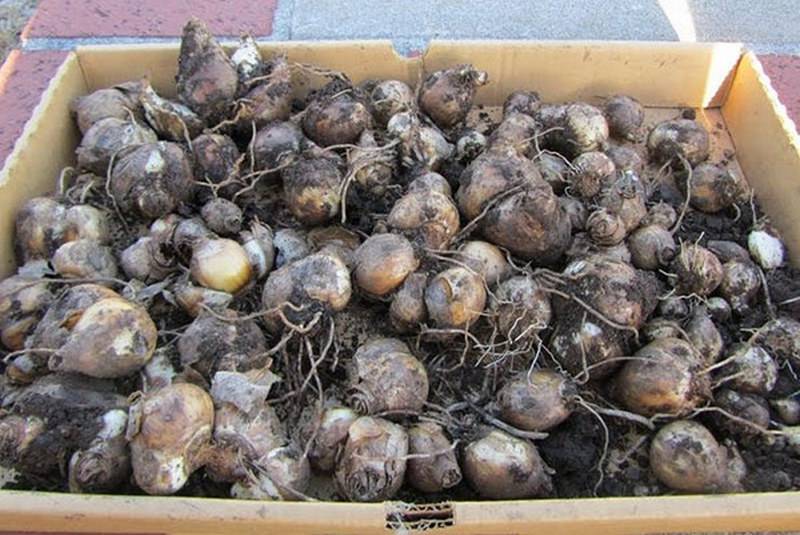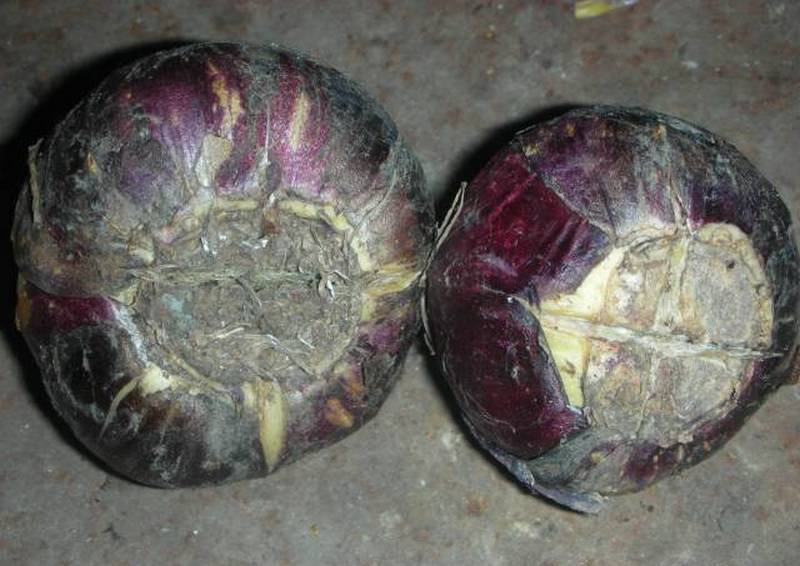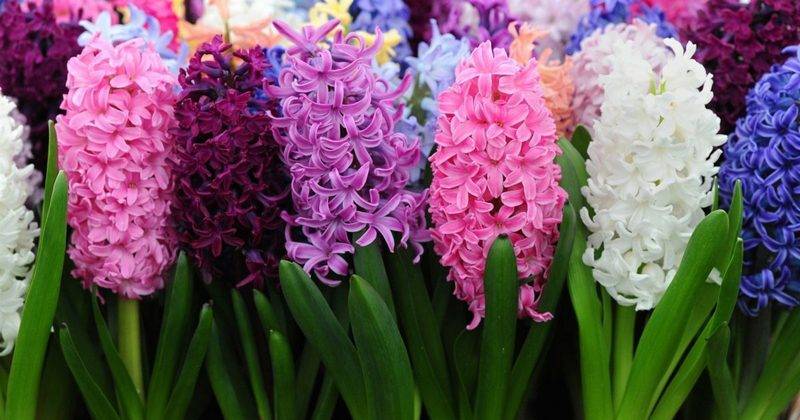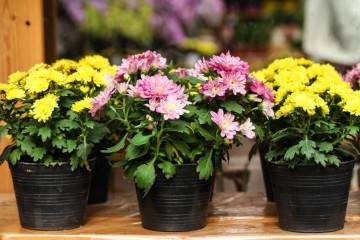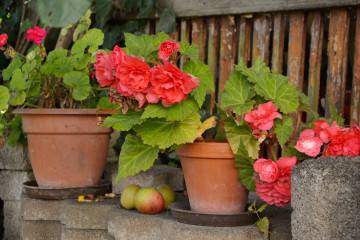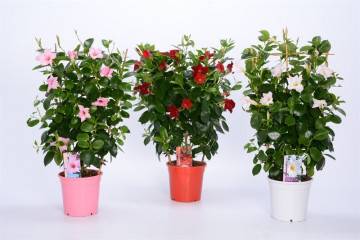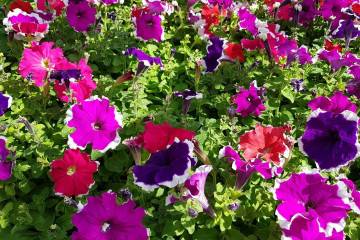Hyacinth - home care, growing in a pot
Content:
Hyacinth is a perennial bulbous plant of the Liliaceae family. The Mediterranean is considered its homeland. The Dutch became interested in bell-shaped flowers in the distant 18th century. It was they who bred numerous varieties of hyacinth with double and simple flowers. To get a beautiful, fragrant and delicate hyacinth, home care in a pot consists in maintaining soil moisture, a certain air temperature and applying fertilizers.
Hyacinth - home care
Bulbous flowers of hyacinths used to be associated with spring, but now, due to the fact that fragrant flowers can be used for forcing and grown in an apartment, it has become possible to enjoy their flowering at any time of the year. In order for hyacinth to please with beautiful inflorescences in winter, you need to know what conditions it needs for flowering.
Forcing bulbs at home
You can buy quality planting material only in specialized stores or supermarkets. When buying hyacinth bulbs, you need to inspect and make sure that there is no disease and rot.
The bulb should be firm and smooth. This is a prerequisite for a healthy plant. A good planting material will have a clear neck and shoulders.
It is better to buy bulbs at the end of summer. The optimum diameter of the planting material is 5 cm.
Choosing a pot and soil for planting bulbs
To see the charming hyacinth bloom at home in winter, it is recommended that you carefully prepare the soil for distillation.
In the store you can buy ready-made soil, which is recommended for growing Saintpaulias or begonias. The soil is already balanced, so only baking powder can be added to it: sand or perlite. The bottom of the pot should be filled with drainage material.
If it is not possible to buy, you can cook it yourself. To do this, you need to take 1 part:
- turf land;
- humus;
- sand;
- peat;
- leafy land.
After preparing the components, the mixture must be thoroughly mixed.
Gorgeous bouquets of hyacinths can be obtained by planting different varieties of plants in one pot. For flowering, you do not need to use a spacious container. The smaller the pot, the faster the hyacinth will release the peduncle.
The bulb can be planted in a clay, ceramic or plastic pot. The material has no effect on flowering.
In pots painted under Gzhel, hyacinths with blue and purple flowers look beautiful.
To get flowers by a certain time, it is necessary to provide the bulbs with a cool content in the fall. It is recommended to keep the temperature at +5 ° C, but not higher than +9 ° C.
This content is necessary for the bulb for 2 months.And when the first shoots appear, hyacinth needs conditions such as spring. The transition to higher temperatures must be carried out gradually, otherwise the flower will disappear.
Leaving during flowering
It must be remembered that the plant is primarily a decoration of the garden, and only then can we say that hyacinth can be a home flower. When grown in apartment conditions, it is recommended to create such conditions as close as possible to natural ones.
Lighting
Forcing is desirable to carry out on the windows on the south and southeast side. Hyacinths are light-loving plants, so they gravitate towards light and must receive natural light for 15 hours a day. If the windows in the apartment face north, it will be necessary to arrange additional lighting with fluorescent lamps.
However, for all the plant's love for bright lighting, it should be remembered that direct sunlight can only cause harm. At noon, it is recommended to remove the flower pots from the windowsill and rearrange them away from the scorching rays of the sun.
Temperature
The presence of drafts, sharp jumps in temperature lead to a slowdown in plant development. During planting and caring for hyacinths at home, the temperature should be maintained at +20 ° C. If the temperature is above zero, you can take it out to the balcony
Watering and spraying
Hyacinths need gentle, regular watering. When watering, it is important not to wet the vegetative parts of the plant, as this will lead to decay.
Florists advise watering by immersing the pot in water or through a sump.
Top dressing
Timely application of fertilizers has a positive effect on the development of the plant. As a top dressing, you can apply a complex fertilizer purchased at a store. Watering with liquid fertilizer is carried out only after preliminary moistening of the soil in the pot.
Post-flowering care
After the flowering of the inflorescences, the decorativeness of the plant is equated to zero: the rosette of green leaves begins to turn yellow, disintegrates, the leaf plates dry.
After flowering, the plant needs special care:
- It is necessary to provide it with uniform watering in order to prevent drying out and waterlogging of the soil.
- The pot should be placed on a light windowsill, and not put away in a dark place. You should be aware that at this time, daughter bulbs are formed near the mother bulb, which are subsequently used for reproduction.
- All peduncles must be removed in time.
Bulbs that have bloomed indoors should never be used for re-forcing in the house. In order for them to regain their strength, they will need to be planted in open ground, because forced flowering is not always beneficial.
Planting hyacinths in the garden is carried out in the middle of autumn. The site must be well drained, without stagnant water.
After the bulbs have been in the garden for 1 or 2 years, they can be used for forcing in the house again.
Storing bulbs at home
Before sending the bulbs for storage, it is necessary to disinfect them in a weak solution of potassium permanganate. After that, dry the planting material for a week. Cannot be dried in the sun. It is best to carry out this procedure in a dark, dry room at a temperature of +20 ° C.
Before sending to the solution, you need to remove excess soil and remove dried scales.Particular attention should be paid to maternal bulbs with already formed babies. To stimulate the appearance of daughter bulbs, cruciform incisions are made at the bottom of an adult bulb.
When sorting is carried out, the children should be separated, the resulting material should be put into prepared boxes and sprinkled with sawdust. For storage, paper bags are still used.
Stages of bulb storage:
- Maintain the temperature at +25 ° C for 8 weeks.
- At the 9th week, the temperature is reduced to +18 ° C.
- Immediately before planting, the bulbs are placed in extreme conditions at + 4 ° C to accustom them to outdoor conditions.
During storage, air humidity plays an important role. It is advisable to keep the bulbs in a dry room, but the planting material should not be allowed to dry out. Adult copies can be stored in paper bags on the bottom shelf of the refrigerator.
Sick material is discarded before being sent for storage. What to do with it? The earlier the disease is detected, the better. Such bulbs must be processed in a dark solution of potassium permanganate and stored separately from healthy specimens.
Reproduction methods
In natural conditions, hyacinths can be propagated by children. This method is very tedious when breeding at home, because the appearance of the bulbs takes a long time. But with patience, you can get strong and healthy plants.
Thanks to breeding work and the works of florists, the following methods of hyacinth propagation were obtained:
- seed reproduction;
- department of children;
- dissection of the bulb;
- cutting out the bottom;
- scales.
The longest way to get new specimens is by seed propagation. This method is often used only by breeders to develop new varieties.
Department of children
This is the simplest, most productive method. With this reproduction, new plants repeat all the characteristics of the mother. The method gives 100% survival rate. For novice gardeners, this is the best option.
To stimulate the appearance of children, a cruciform incision is made at the bottom.
Cutting the bottom
Experienced growers use large bulbs for propagation.
Step-by-step instruction
- First, the planting material is cleaned and washed.
- Next, the bulbs are dried for a week.
- At the bottom of the hole, a cone-shaped depression is made using a sharp knife.
- Activated carbon or any fungicide is used to treat the wound.
- Prepared bulbs are laid with their bottom up, the planting material is covered with a film.
The appearance of the first babies can be observed after 2 months. These bulbs can already be planted in the ground.
Cuttings
Cutting the cuttings takes place at a time when the buds are forming on the plant. The bottom of the cutting must be dipped in a solution of a rooting stimulator. Rooting is carried out under a film. A month later, survival is observed, and after 1.5 months, young sprouts appear. No new bulbs should be dug out for 2 years. For the winter, they should be thoroughly mulched.
Dissecting the onion
For the procedure, large planting material is required. Use a sharp knife to divide the bulbs into 5 pieces. Each of them must be divided into flakes and all media must be treated with ash.
To get beautiful flowers in winter, you only need a desire. These detailed instructions will help you get beautiful bouquets and take proper care of your plantings.
Pruning
When the arrow with the flower droops, it must be cut off. It is recommended not to delay this procedure in order to prevent the setting of the seed in the seed pods.If the moment is missed, the plant will spend all its energy on seed formation and will lose a sufficient portion of its nutrients. The bulb itself will weaken and become unsuitable for further cultivation.
Diseases and pests
The list of especially dangerous insect pests for hyacinths includes thrips, root and root nematodes, aphids, flower flies and spider mites.
With a massive defeat of hyacinth, the leaves turn yellow, wilting of plates, buds is observed, and when examining the bulbs, you can observe the following picture - they become loose and soon rot.
It is important to determine which pest attacked the plant. And only then proceed to the choice of insecticides or alternative methods. It is better to buy preparations for removing pests in specialized stores, where it is possible to consult with the seller.
In addition to pests, these plants often suffer from infectious, bacterial, viral, diseases. Diseases can also be non-communicable.
Soft bacterial rot can be problematic. To detect a disease, you need to examine the plant. Signs of the disease are:
- blackening of foliage and drying it at the very tips;
- the presence of watery brown stripes along the veins;
- blotches and irregular yellow spots can be seen on the bulbs.
All these manifestations lead to decay, hyacinths can no longer be saved. To avoid spreading the infection to neighboring plantings, it is recommended
To get blooming hyacinths by March, you need to plant bulbs in January. It is not difficult to look after representatives of the Liliaceae family, so even a novice florist can start forcing charming flowers and delight themselves with their flowering in winter.
